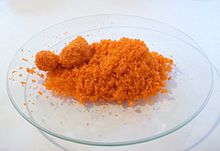
| |

| |
| Names | |
|---|---|
| IUPAC name
Sodium dichromate
| |
| Other names
Chromic acid disodium salt
| |
| Identifiers | |
| |
3D model (JSmol)
|
|
| ChEBI | |
| ChemSpider | |
| ECHA InfoCard | 100.031.070 |
| EC Number |
|
| 21597 | |
PubChem CID
|
|
| RTECS number |
|
| UNII |
|
| UN number | 3288 |
CompTox Dashboard (EPA)
|
|
| |
| |
| Properties | |
| Na2Cr2O7 | |
| Molar mass | 261.97 g/mol (anhydrous) 298.00 g/mol (dihydrate) |
| Appearance | bright orange |
| Odor | odorless |
| Density | 2.52 g/cm3 |
| Melting point | 356.7 °C (674.1 °F; 629.8 K) |
| Boiling point | 400 °C (752 °F; 673 K) decomposes |
| 73 g/100 mL at 25 °C | |
| Solubility in other solvents | soluble in methanol, ethanol |
Refractive index (nD)
|
1.661 (dihydrate) |
| Hazards | |
| GHS labelling: | |
     
| |
| Warning | |
| H272, H301, H312, H314, H317, H330, H334, H340, H350, H360, H372, H410 | |
| P201, P202, P210, P220, P221, P260, P261, P264, P270, P271, P272, P273, P280, P281, P284, P285, P301+P310, P301+P330+P331, P302+P352, P303+P361+P353, P304+P340, P304+P341, P305+P351+P338, P308+P313, P310, P312, P314, P320, P321, P322, P330, P333+P313, P342+P311, P363, P370+P378, P391, P403+P233, P405, P501 | |
| NFPA 704 (fire diamond) | |
| Lethal dose or concentration (LD, LC): | |
LD50 (median dose)
|
50 mg/kg |
| Safety data sheet (SDS) | ICSC 1369 |
| Related compounds | |
Other anions
|
Sodium chromate Sodium molybdate Sodium tungstate |
Other cations
|
Potassium dichromate Ammonium dichromate |
Except where otherwise noted, data are given for materials in their standard state (at 25 °C [77 °F], 100 kPa).
| |
Sodium dichromate is the inorganic compound with the formula Na2Cr2O7. However, the salt is usually handled as its dihydrate Na2Cr2O7·2H2O. Virtually all chromium ore is processed via conversion to sodium dichromate and virtually all compounds and materials based on chromium are prepared from this salt.[1] In terms of reactivity and appearance, sodium dichromate and potassium dichromate are very similar. The sodium salt is, however, around twenty times more soluble in water than the potassium salt (49 g/L at 0 °C) and its equivalent weight is also lower, which is often desirable.[2]
- ^ Gerd Anger, Jost Halstenberg, Klaus Hochgeschwender, Christoph Scherhag, Ulrich Korallus, Herbert Knopf, Peter Schmidt, Manfred Ohlinger, "Chromium Compounds" in Ullmann's Encyclopedia of Industrial Chemistry, Wiley-VCH, Weinheim, 2005. doi:10.1002/14356007.a07_067
- ^ Freeman, F. "Sodium Dichromate" in Encyclopedia of Reagents for Organic Synthesis (Ed: L. Paquette) 2004, J. Wiley & Sons, New York. doi:10.1002/047084289X.
